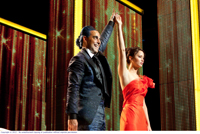
Rising Sun Pictures took on major action sequences and environments in ‘The Hunger Games’, creating and animating elements from the all-digital Capitol City to the vicious Muttations.
| On set in North Carolina, VFX supervisor Dennis Jones from RSP in Adelaide, South Australia, oversaw the shoots for two of Rising Sun Pictures’ sequences in ‘The Hunger Games’, the Muttations chase and the Tribute Parade. He visited the location twice for about a week of shooting each time, when he and and productioin VFX Supervisor Sheena Duggal worked with the director Gary Ross. Later in September that year, the facility’s VFX supervisor John Dietz came on board when post was getting well underway. | |
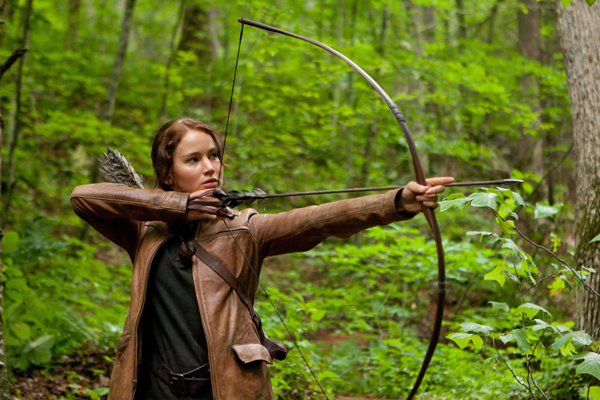 |
|
| The production had completed the director’s cut and released one trailer, and were gaining a clearer idea of the footage they had to work with to tell their story. They also began to realize the great potential the film might have in cinemas. Extra vendors were hired as expectations grew. Over the last four months of post production, John’s role at RSP expanded, and the facility contributed over 200 shots.
Capitol Character The principle parts of this environment included the Presidential Avenue, venue of the Tributes Parade. Overall it comprises a complex environment full of tension and activity, and required inventing a completely original architectural style from scratch. Following an initial phase to define clearly what this world should look and feel like, the team’s design work continued even as they started creating the shots, enhancing the buildings and devising distinctive architectural elements such as the metal detailing, ornaments, statues and window fixtures. “The aim was to produce a cold, concrete or stone-like quality, embellished with some bold details,” said John. “The old ‘World Capital Germania’ idea, also present in the previous pre-production concepts, was a source of inspiration for us. The cityscape needed to take on a character role as well and play a significant part in the story by showing what the Capitol represents to the characters. ‘The Hunger Games’ novels were continuously referenced as source material. Particularly for Rising Sun’s main sequences, Gary Ross followed the books closely.” Crowded Out |
|
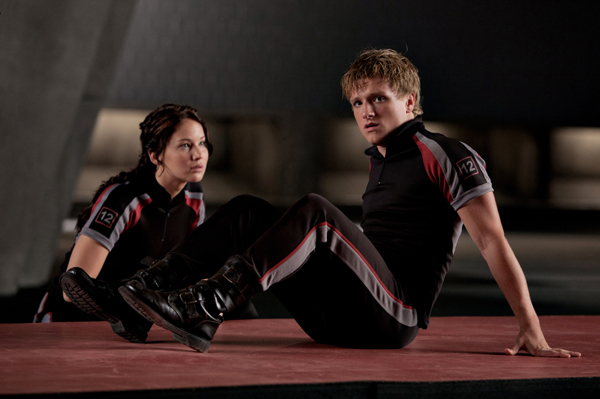 |
|
| In the case of the pivotal Tributes Parade sequence, which needed extensive crowds, the shoot had been carefully previs’ed and the team knew what most of the camera angles would be, even before any crowd elements had been shot. The virtual set was going to be huge, so the crew shifted this small crowd around the set into the required areas in a stand to accommodate the camera angles. These same images could be used for close-ups as well, and spots that hadn’t been covered could be filled in later on with digital Massive crowds, rendered based on the reference images for lighting.
Cityscapes “The night before the Games start, Katniss and Peeta are sitting out on a window ledge gazing out over the city, one of several from city apartment windows extending the interior sets. They were all 2.5D projections, rendered, painted per scene and composited into the shot. Such shots also included expressive camera-style features like bokeh effects and custom focus to introduce a warm lively feeling with a combined palette,” John explained. “In this particular example you hear the noise of the crowd below rise into chanting as the camera crosses over to a wide establisher right out in the city and the night shot dissolves to daylight – the morning of the Games. Both shots required conscious planning, and were laid out first in CG to create the building geometry, plus specific camera moves. A number of passes were rendered to control the shading. Then we built up the matte paintings on top of these passes and re-projected the paintings onto the geometry. A handful of other wide establishing shots were specifically composed in a similar way, some also incorporating Massive crowds.” In a transition shot like this one, the cut was important to the CG. John felt the editing on ‘The Hunger Games’ was excellent and inclined to keep moving through the shots instead of lingering on establishers as is conventional, resulting in a pacier feeling. A dedicated VFX editor, Chris Capp, and team were usually present during the VFX reviews and would convey notes from the film’s main editors. |
|
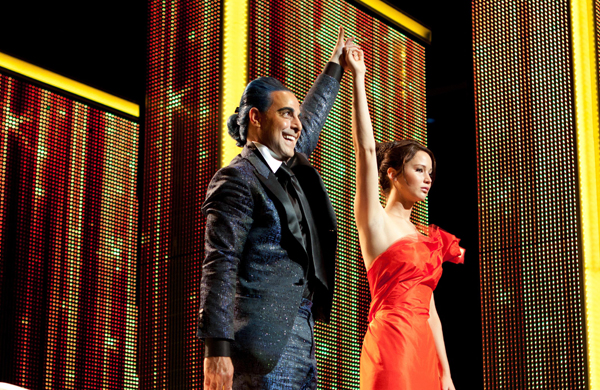 |
|
| Shot Building The camera work also directly affected the VFX tam at RSP for both the high action Muttations attack sequence and the Tributes Parade. The Parade, entirely CG except for the foreground actors, was a critical sequence and carefully previs’ed but when it was put together, they found it was strangely lacking the energy and dynamism of the rest of the movie when viewed at a temporary screening. John said, “We had to go back and revisit the elements and camera work to improve the sequence, which needed to be pretty exciting. So we chose some of the most effective, live action shots from elsewhere in the movie and analysed those camera moves, tracking the camera in 2D or even 3D, and applied similar moves into the Parade shots. The shooting style – focus pulls, composition, flares and other artefacts – was adopted as well. “All of this helped us fit that crucial sequence stylistically into the whole show. We were fortunate to have some time in the schedule to polish up the look with chromatic aberrations and lens effects as well. The ability to add this kind of photographic naturalism really helps ground CG into the real world. We applied some of these effects with compositing techniques in Nuke, some as 2D elements.” Motion Study Furthermore, they had the motion of the actors themselves coordinating with the chariot motion, slightly offset. Once we had identified those three sources of movement – camera, chariots, actors - and analysed the motion throughout, making these Parade shots really work dynamically involved applying it consistently. If necessary, even bits of clothing and hair could be warped to match the secondary shake. Wings of Fire |
|
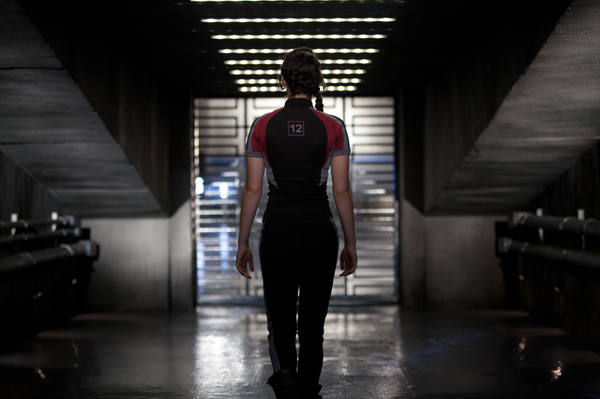 |
|
|
“Of course, this was not a supernatural story,” said John. “The book described the wings as a type of cloth that looked and felt like cool fire. So a realistic but stylised look was decided on. We determined its colour and internal movement pretty readily - but how to give it a wing shape?” The size of the licks, flow, shape and direction were harder to settle on, requiring many versions to look effective at all angles, close up and at a distance, while flowing at speed behind the chariot. The apparent speed varied quite a bit depending on the camera angle, and affected continuity. Katniss’ flaming dress used similar-looking fire. But these flames had to emerge from the small folds of the cloth as she spins around, amid sparks. The dress and its complex in-curves had to be completely tracked to determine precisely where the folds were located in the plate. Then they used this digital, tracked shape to plot just where and how the dress should emit flames in all spots in 3D space at any moment. Adding Drama Similar techniques were also used in the Muttations chase, which takes place at night. The plates were shot from a cart with the camera attached, holding it about 2 metres from the ground, pointing down at where the Mutts would be running. This cart would move through the forest, capturing the background footage. However, using this camera angle would only have shown the creatures’ backs and tops of their heads. What needed to be at the centre of the frame and the audience’s attention were their awesome jaws and teeth to create one of the film’s most frightening sequences. The team at RSP tracked the plate from the high angle, then re-created a digital environment from that track with the shapes of the main trees and ground plane, and projected the image from the camera angle back onto the geometry, while moving the camera down eye-to-eye with the Mutts. They could paint and add in more trees later on. The result would be the same basic shot as the previs, through the new camera angle. Completing this shot in particular involved close collaboration with the director. Pack of Danger Interestingly, in the Games Control Centre where every moment of the Games is watched and manipulated, we first see one of the Mutts in quite a different form, standing in a miniature wireframe version on the Controllers’ revolving maps of the Games terrain as they plot when and where to send the pack out. This form had its own challenges for the animators. The team needed to convey an alert, alive, very dangerous creature, but in a wireframe model the size of a puppy. As they experimented with moves, they found that this small Mutt often looked ‘cute’, pawing the ground, and while its facial performance was right, it was difficult to read the wireframe features. Out of Nowhere Their faces especially were designed to resemble human faces in profile without the pronounced muzzle of a dog. The neck and shoulders were also jointed in a more human fashion. Boxers were a strong influence, instead of the typical Rottweiler attack-dog build. “We wanted them to be agile and light on their feet. VFX animation consultant Daniel Jeannette worked on the speed and motion of their performance as a principle way to express the danger and power they represent,” John said. “He went through the sequence shot for shot deciding how to add conflict and build the threat. For example, when Katniss and Peeta scramble onto the Cornucopia with the dogs snapping up towards camera, that camera moves closer with each progressive shot. We had the lights pop on their teeth as they move into pools of light, as if out of nowhere.” www.rsp.com.au Words: Adriene Hurst |
|


















